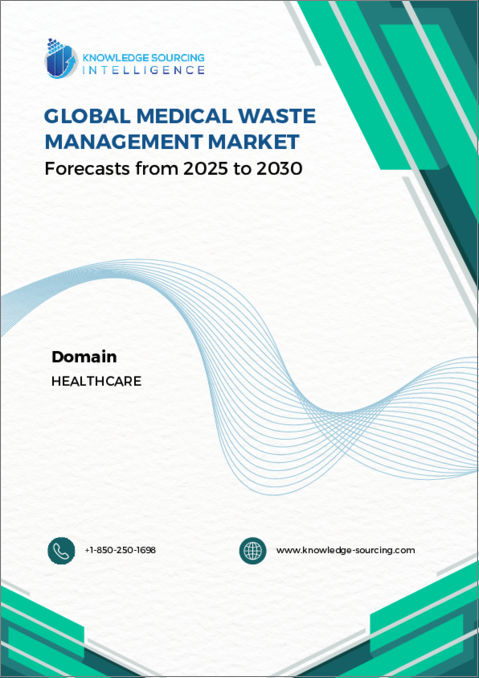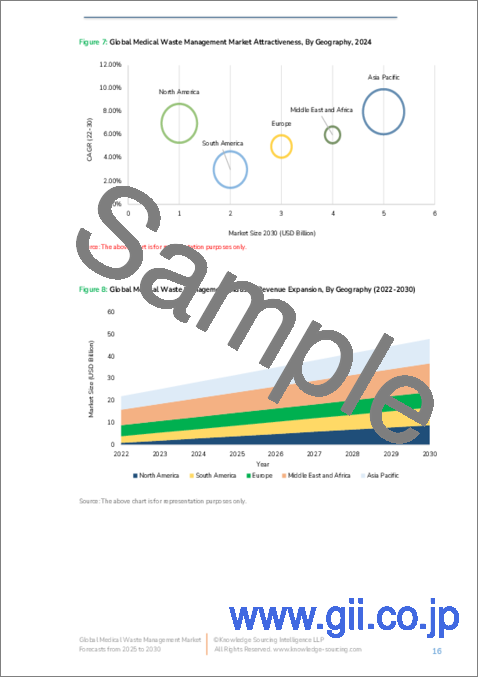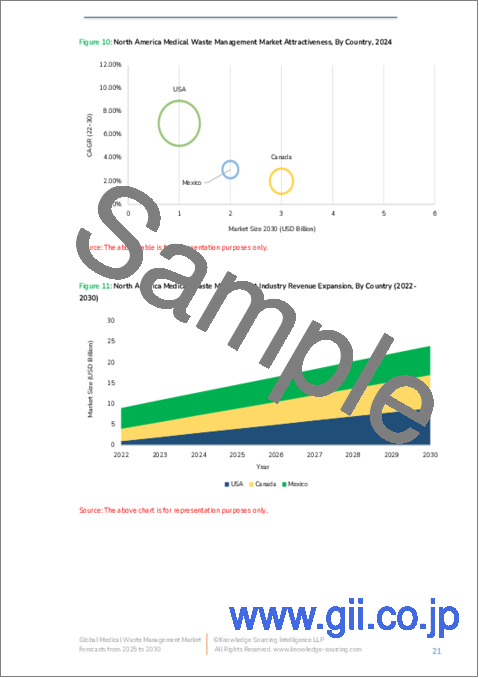|
|
市場調査レポート
商品コード
1495974
医療廃棄物管理の世界市場-2024年から2029年までの予測Global Medical Waste Management Market - Forecasts from 2024 to 2029 |
||||||
カスタマイズ可能
|
|||||||
| 医療廃棄物管理の世界市場-2024年から2029年までの予測 |
|
出版日: 2024年04月16日
発行: Knowledge Sourcing Intelligence
ページ情報: 英文 134 Pages
納期: 即日から翌営業日
|
- 全表示
- 概要
- 目次
医療廃棄物管理市場は予測期間中にCAGR 5.87%で成長し、2022年の172億900万米ドルから2029年には255億6,200万米ドルに達すると予測されています。
医療廃棄物は、医療機関で実施される医療、外科、処理処置の結果として発生します。病院、診断機関、クリニックでは、適切に処理・管理されなければならない廃棄物が発生します。医療廃棄物管理とは、焼却、化学処理、オートクレーブ処理など、さまざまなサービスを通じた生物医療的廃棄物の収集、処理、処分と定義されます。
医療廃棄物管理は、生物医療的廃棄物が収集され、封じ込められ、処理され、適切に処分されることを保証し、一般市民、動物、環境を保護します。市場セグメンテーションは、廃棄物タイプ、処理場所、サービス、地域によって区分されます。
市場促進要因
- 生物医療的廃棄物の量の増加が、予測期間中の医療廃棄物管理市場の成長を後押しすると予想されます。
医療廃棄物の大部分は、様々な病気の処理や試験の結果として発生します。医療活動によって発生する廃棄物の約85%は非危険物です。同様に、廃棄物の約15%は有害であり、有毒で感染性があり、深刻な健康リスクをもたらします。WHOによると、2018年には世界中で160億本以上の注射が実施されたため、医療廃棄物を安全に処理するための適切かつ十分な処理が必要となりました。その結果、医療廃棄物管理市場は、健康危機を回避するために安全な注射処理への需要が高まるにつれて成長すると予想されます。
COVID-19の大流行の結果、病院では使い捨てウェットティッシュや消毒用空容器など、より多くの非危険物医療廃棄物を排出するようになり、医療廃棄物管理業界を前進させています。さらに、労働安全衛生局(OSHA)や麻薬取締局(DEA)などの連邦機関は、COVID-19医療廃棄物に対する特定の廃棄基準を設けています。これらのガイドラインは医療廃棄物管理プロセスを簡素化し、改善するものであり、その結果、医療廃棄物管理の受け入れが増加しています。中央公害管理委員会によると、インドでは診断活動やCOVID-19患者の処理が増加した結果、2020年6月から2021年5月にかけて4万5,308トンの生物医療廃棄物が発生しました。
さらに、医療廃棄物の管理を改善しようとする政府の試みが市場を前進させています。例えば、米国環境保護庁は2019年に「有害廃棄医薬品の管理基準とニコチンのP075リスト修正」と題する規則に署名し、有害医薬品廃棄物処理の合理化規則を概説しました。さらに、研究活動への資金提供の増加やバイオメディカル製品・技術の普及が市場拡大の原動力となっています。例えば、インドのヒマーチャル・プラデーシュ州は2021年5月、発生する医療廃棄物の負担を軽減するため、新たな共通のバイオ医療廃棄物処理・処分施設を認可することで、バイオ医療廃棄物の焼却量を1日当たり2.4トン(MT)から6.4トン(MT)に増やす計画を発表しました。同様に、中国政府と国連開発計画(UNDP)は2021年8月、ネパールにおける新たな取り組みを発表し、南アジア諸国の7つの病院が医療廃棄物管理システムを改善し、新興諸国のパンデミックによりよく対処できるよう支援することを明らかにしました。
予測期間中、北米が医療廃棄物管理市場の成長を牽引すると見られています。
慢性疾患の罹患率が上昇しているため、大手企業の存在によって廃棄物管理に関する環境意識が高まり、同地域の医療廃棄物量の増加につながりました。北米は医療廃棄物管理市場で大きな割合を占めると考えられます。米国では、多くの病院が使い捨て製品のリサイクルを開始しており、その製品はその後、病院に安価で販売されています。
この地域の多くの企業は、市場での存在感を高めるため、提携、契約、合併、買収など様々な成長方法を追求しています。例えば、米国の廃棄物管理、総合廃棄物管理、環境サービス企業であるWaste Management, Inc.は、2019年にAdvanced Disposal Services, Inc.に46億米ドルを支払った。この買収により、Waste Managementのプレゼンスは拡大し、米国内16州で300万を超える新たな商業、産業、住宅顧客に、差別化されたサステイナブル廃棄物管理・リサイクルサービスを比類のないレベルで提供できるようになりました。
会社の製品/サービス
- 医薬品廃棄物管理・処理-医薬品廃棄物管理・処理サービスは、Stericycle, Inc、
- 病理廃棄物-Mediwasteは、ヒト由来の組織、臓器、体の一部、脊椎動物由来の組織、臓器、体の一部など、研究で使用された認識可能な病理廃棄物に関するサービスを提供しています。
- バイオハザード廃棄物処理管理-BioMedical Waste Solutions, LLCは、完全なオフィス廃棄物処理用品、文書破棄証明、レッドバッグ生物医療廃棄物除去、OSHA医療施設コンプライアンス・トレーニング・プログラム、HIPAAコンプライアンス、医薬品廃棄物処理、期限切れ/リコール医薬品破棄、様々な感染性廃棄物やシャープスビン容器廃棄サービスラインを含む、完全なバイオハザード廃棄物処理管理サービスを提供しています。
主要開発
- 2024年2月-Clean HarborsはGryphon Investorsと提携し、米国東部における専門的な環境・緊急対応サービスの大手プロバイダーであるHEPACOを現金4億米ドルで買収。この買収は、規制当局の承認と完了条件次第で、2024年前半に完了する予定。
- 2022年8月-日本政府と国連開発計画(UNDP)は、バングラデシュ、ブータン、モルディブにおけるCOVID-19パンデミックによる感染性医療廃棄物の急増に対処し、廃棄物管理を改善することを目標に、2年間で1,100万米ドルのプロジェクトを開始しました。各国の保健機関や主要関係者を支援することを目的としたこのイニシアチブは、大須賀毅大使とカンニ・ウィグナラジャ大使が出席した式典で正式に発足しました。
- 2022年5月-SUEZとVeoliaは、欧州委員会の競争に関する懸念に対処するというVeoliaのコミットメントの一環として、フランス国内のすべての有害廃棄物資産(6億9,000万ユーロ相当)を買収する契約を締結。
- 2022年5月-バミューダを拠点とするMediWasteは、保健省とBHBから医療廃棄物の収集・処分を引き継ぎ、歯科医、医院、研究所、クリニック、獣医師クリニック、タトゥーパーラー、薬局、理髪店などの地域発生業者に直接サービスを提供。MediWasteは、医療廃棄物処理用に特別に設計された2台の焼却炉を使用し、国際規格に準拠したベストプラクティスのバイオハザード廃棄物の収集、運搬、処理、処分を専門としています。
主要市場セグメンテーション
廃棄物タイプ別
- 一般廃棄物
- 有害廃棄物
- 感染性廃棄物
処理場所別
- オンサイト
- オフサイト
サービス別
- 処理
- 廃棄
- リサイクル
地域別
- 北米
- 米国
- カナダ
- メキシコ
- 南米
- ブラジル
- アルゼンチン
- その他
- 欧州
- ドイツ
- フランス
- 英国
- スペイン
- その他
- 中東・アフリカ
- サウジアラビア
- イスラエル
- その他
- アジア太平洋
- 中国
- 日本
- 韓国
- インド
- その他
目次
第1章 イントロダクション
- 市場概要
- 市場の定義
- 調査範囲
- 市場セグメンテーション
- 通貨
- 前提条件
- 基準年と予測年のタイムライン
- ステークホルダーにとっての主要メリット
第2章 調査手法
- 調査デザイン
- 調査プロセス
第3章 エグゼクティブ概要
- 主要調査結果
第4章 市場力学
- 市場促進要因
- 市場抑制要因
- ポーターのファイブフォース分析
- 業界バリューチェーン分析
- アナリストビュー
第5章 医療廃棄物管理の世界市場:廃棄物タイプ別
- イントロダクション
- 一般廃棄物
- 有害廃棄物
- 感染性廃棄物
第6章 医療廃棄物管理の世界市場:処理場所別
- イントロダクション
- オンサイト
- オフサイト
第7章 医療廃棄物管理の世界市場:サービス別
- イントロダクション
- 処理
- 廃棄
- リサイクル
第8章 医療廃棄物管理の世界市場:地域別
- イントロダクション
- 北米
- 南米
- 欧州
- 中東・アフリカ
- アジア太平洋
第9章 競合環境と分析
- 主要企業と戦略分析
- 市場シェア分析
- 合併、買収、合意とコラボレーション
- 競合ダッシュボード
第10章 企業プロファイル
- Stericycle, Inc.
- SUEZ
- Veolia
- CLEAN HARBORS, INC.
- Waste Management, Inc.
- BioMedical Waste Solutions, LLC
- REMONDIS Group
- Daniels Health
- BWS Incorporated
- Gamma Waste Services
The global medical waste management market is projected to grow at a CAGR of 5.87% during the forecast period to reach US$25.562 billion by 2029, up from US$17.209 billion in 2022.
Medical waste is generated as a result of medical, surgical, and therapeutic procedures carried out in healthcare institutions. Hospitals, diagnostic institutes, and clinics generate waste that must be properly handled and managed. Medical waste management is defined as the collection, treatment, and disposal of biomedical waste through various services, such as incineration, chemical treatment, and autoclaving.
Medical waste management assures that biomedical waste is collected, contained, processed, and properly disposed of, safeguarding the general public, animals, and the environment. The global medical waste management market is segmented by waste type, treatment site, service, and geography.
Market Drivers:
- The increasing volume of biomedical waste is expected to boost the global medical waste management market's growth during the forecast period.
The majority of medical waste is generated as a result of various disease treatments and tests. Approximately 85% of waste generated by healthcare activities is non-hazardous. Similarly, around 15% of waste is hazardous, meaning it is toxic and infectious, posing a serious health risk. According to the WHO, over 16 billion injections were administered worldwide in 2018, necessitating proper and adequate processing to dispose of medical waste safely. As a result, the medical waste management market is expected to grow as the demand for safe injection disposal grows to avert health crises.
As a result of the COVID-19 outbreak, hospitals are producing more non-hazardous medical waste, such as disposable wipes and empty disinfection containers, propelling the medical waste management industry forward. Furthermore, federal agencies such as the Occupational Safety and Health Administration (OSHA) and the Drug Enforcement Administration (DEA) have specific disposal standards for COVID-19 medical waste. These guidelines simplify and improve the medical waste management process, resulting in increased acceptance of medical waste management. According to the Central Pollution Control Board, India generated 45,308 tons of biomedical waste between June 2020 and May 2021 as a result of an increase in the number of diagnostic activities and treatment of COVID-19 patients.
Furthermore, government attempts to improve the management of medical waste are propelling the market ahead. The US Environmental Protection Agency, for example, signed a rule in 2019 titled "Management Standards for Hazardous Waste Pharmaceuticals and Amendment to the P075 listing for Nicotine", which outlines streamlined rules for treating hazardous pharmaceutical waste. Furthermore, increased funding for research activities and the widespread use of biomedical products and technologies are driving market expansion. For instance, to reduce the burden of medical waste generated, the Indian state of Himachal Pradesh announced plans in May 2021 to increase the volume of bio-medical waste incineration from 2.4 metric tonnes (MT) per day to 6.4 MT per day by authorizing a new common bio-medical waste treatment and disposal facility. Similarly, the Chinese government and the United Nations Development Program (UNDP) announced a new effort in Nepal in August 2021 to assist seven hospitals in the South Asian country in improving their healthcare waste management systems to better address the COVID-19 pandemic.
North America is expected to drive the global medical waste management market growth during the forecast period.
Because of the rising incidence of chronic diseases, the presence of major players has increased environmental consciousness regarding waste management and led to an increase in the amount of medical waste in the region. North America is likely to hold a significant proportion of the medical waste management market. In the United States, many hospitals have started recycling single-use products, which are subsequently sold back to the hospitals at a reduced price.
Many companies in the region are pursuing various growth methods such as collaborations, agreements, mergers, and acquisitions to strengthen their market presence. For example, Waste Management, Inc., a US-based waste management, comprehensive waste management, and environmental services firm, paid $4.6 billion for Advanced Disposal Services, Inc. in 2019. The acquisition expands Waste Management's presence and allows the firm to provide an unrivaled level of differentiated, sustainable waste management and recycling services to over 3 million new commercial, industrial, and residential customers in 16 states throughout the US.
Company Products/ Services:
- Pharmaceutical Waste Management and Disposal- Pharmaceutical Waste Management and Disposal services are provided by Stericycle, Inc., which include compliance-based pharmaceutical waste disposal solutions to help you manage waste safely, effectively, and with the least amount of risk.
- Pathological Waste- Mediwaste offers services related to pathological waste which recognizable human-derived tissues, organs, body parts, vertebrate animal-derived tissues, organs, and body parts used in research.
- Biohazardous Waste Disposal Management- BioMedical Waste Solutions, LLC offers complete biohazardous waste disposal management service, including complete office disposal supplies, document destruction certification, red bag biomedical waste removal, OSHA Medical Facility compliance training programs, HIPAA compliance, pharmaceutical waste disposal, expired/recalled drug destruction, and various infectious waste and Sharps bin container disposal service lines.
Key Developments:
- February 2024- Clean Harbors partnered with Gryphon Investors to acquire HEPACO, a leading provider of specialized environmental and emergency response services in the Eastern United States, for $400 million in cash. The acquisition is expected to close in the first half of 2024, subject to regulatory approval and closing conditions.
- August 2022 - The Japanese government and the United Nations Development Programme (UNDP) launched a two-year $11 million project to help address the surge in infectious healthcare waste caused by the COVID-19 pandemic in Bangladesh, Bhutan, and the Maldives and targets to improve waste management. The initiative, which aims to support national health agencies and key stakeholders, was officially launched at a ceremony attended by H.E. Ambassador Takeshi Osuga and Kanni Wignaraja.
- May 2022- SUEZ and Veolia signed an agreement to acquire all hazardous waste assets in France, valued at 690 million euros, as part of Veolia's commitment to address European Commission competition concerns, as part of their commitment to address the company's concerns.
- May 2022- MediWaste, a Bermuda-based company, took over the collection and disposal of medical waste from the Department of Health and BHB, providing direct access to services for community generators like dentists, doctor offices, labs, clinics, veterinarian practices, tattoo parlors, pharmacies, and barbers. MediWaste specializes in internationally compliant and best practice collection, transportation, treatment, and disposal of biohazardous wastes, using two incinerators specifically designed for medical waste disposal.
Key Market Segments:
By Waste Type
- General
- Hazardous
- Infectious
By Treatment Site
- On-site
- Off-site
By Service
- Treatment
- Disposal
- Recycling
By Geography
- North America
- USA
- Canada
- Mexico
- South America
- Brazil
- Argentina
- Others
- Europe
- Germany
- France
- United Kingdom
- Spain
- Others
- Middle East and Africa
- Saudi Arabia
- Israel
- Others
- Asia Pacific
- China
- Japan
- South Korea
- India
- Others
TABLE OF CONTENTS
1. INTRODUCTION
- 1.1. Market Overview
- 1.2. Market Definition
- 1.3. Scope of the Study
- 1.4. Market Segmentation
- 1.5. Currency
- 1.6. Assumptions
- 1.7. Base and Forecast Years Timeline
- 1.8. Key Benefits to the Stakeholder
2. RESEARCH METHODOLOGY
- 2.1. Research Design
- 2.2. Research Processes
3. EXECUTIVE SUMMARY
- 3.1. Key Findings
4. MARKET DYNAMICS
- 4.1. Market Drivers
- 4.2. Market Restraints
- 4.3. Porter's Five Forces Analysis
- 4.3.1. Bargaining Power of Suppliers
- 4.3.2. Bargaining Power of Buyers
- 4.3.3. Threat of New Entrants
- 4.3.4. Threat of Substitutes
- 4.3.5. Competitive Rivalry in the Industry
- 4.4. Industry Value Chain Analysis
- 4.5. Analyst View
5. GLOBAL MEDICAL WASTE MANAGEMENT MARKET BY WASTE TYPE
- 5.1. Introduction
- 5.2. General
- 5.2.1. Market Opportunities and Trends
- 5.2.2. Growth Prospects
- 5.2.3. Geographic Lucrativeness
- 5.3. Hazardous
- 5.3.1. Market Opportunities and Trends
- 5.3.2. Growth Prospects
- 5.3.3. Geographic Lucrativeness
- 5.4. Infectious
- 5.4.1. Market Opportunities and Trends
- 5.4.2. Growth Prospects
- 5.4.3. Geographic Lucrativeness
6. GLOBAL MEDICAL WASTE MANAGEMENT MARKET BY TREATMENT SITE
- 6.1. Introduction
- 6.2. On-site
- 6.2.1. Market Opportunities and Trends
- 6.2.2. Growth Prospects
- 6.2.3. Geographic Lucrativeness
- 6.3. Off-site
- 6.3.1. Market Opportunities and Trends
- 6.3.2. Growth Prospects
- 6.3.3. Geographic Lucrativeness
7. GLOBAL MEDICAL WASTE MANAGEMENT MARKET BY SERVICE
- 7.1. Introduction
- 7.2. Treatment
- 7.2.1. Market Opportunities and Trends
- 7.2.2. Growth Prospects
- 7.2.3. Geographic Lucrativeness
- 7.3. Disposal
- 7.3.1. Market Opportunities and Trends
- 7.3.2. Growth Prospects
- 7.3.3. Geographic Lucrativeness
- 7.4. Recycling
- 7.4.1. Market Opportunities and Trends
- 7.4.2. Growth Prospects
- 7.4.3. Geographic Lucrativeness
8. GLOBAL MEDICAL WASTE MANAGEMENT MARKET BY GEOGRAPHY
- 8.1. Introduction
- 8.2. North America
- 8.2.1. By Waste Type
- 8.2.2. By Treatment Type
- 8.2.3. By Service
- 8.2.4. By Country
- 8.2.4.1. USA
- 8.2.4.1.1. Market Opportunities and Trends
- 8.2.4.1.2. Growth Prospects
- 8.2.4.2. Canada
- 8.2.4.2.1. Market Opportunities and Trends
- 8.2.4.2.2. Growth Prospects
- 8.2.4.3. Mexico
- 8.2.4.3.1. Market Opportunities and Trends
- 8.2.4.3.2. Growth Prospects
- 8.2.4.1. USA
- 8.3. South America
- 8.3.1. By Waste Type
- 8.3.2. By Treatment Type
- 8.3.3. By Service
- 8.3.4. By Country
- 8.3.4.1. Brazil
- 8.3.4.1.1. Market Opportunities and Trends
- 8.3.4.1.2. Growth Prospects
- 8.3.4.2. Argentina
- 8.3.4.2.1. Market Opportunities and Trends
- 8.3.4.2.2. Growth Prospects
- 8.3.4.3. Others
- 8.3.4.3.1. Market Opportunities and Trends
- 8.3.4.3.2. Growth Prospects
- 8.3.4.1. Brazil
- 8.4. Europe
- 8.4.1. By Waste Type
- 8.4.2. By Treatment Type
- 8.4.3. By Service
- 8.4.4. By Country
- 8.4.4.1. Germany
- 8.4.4.1.1. Market Opportunities and Trends
- 8.4.4.1.2. Growth Prospects
- 8.4.4.2. France
- 8.4.4.2.1. Market Opportunities and Trends
- 8.4.4.2.2. Growth Prospects
- 8.4.4.3. United Kingdom
- 8.4.4.3.1. Market Opportunities and Trends
- 8.4.4.3.2. Growth Prospects
- 8.4.4.4. Spain
- 8.4.4.4.1. Market Opportunities and Trends
- 8.4.4.4.2. Growth Prospects
- 8.4.4.5. Others
- 8.4.4.5.1. Market Opportunities and Trends
- 8.4.4.5.2. Growth Prospects
- 8.4.4.1. Germany
- 8.5. Middle East and Africa
- 8.5.1. By Waste Type
- 8.5.2. By Treatment Type
- 8.5.3. By Service
- 8.5.4. By Country
- 8.5.4.1. Saudi Arabia
- 8.5.4.1.1. Market Opportunities and Trends
- 8.5.4.1.2. Growth Prospects
- 8.5.4.2. Israel
- 8.5.4.2.1. Market Opportunities and Trends
- 8.5.4.2.2. Growth Prospects
- 8.5.4.3. Others
- 8.5.4.3.1. Market Opportunities and Trends
- 8.5.4.3.2. Growth Prospects
- 8.5.4.1. Saudi Arabia
- 8.6. Asia Pacific
- 8.6.1. By Waste Type
- 8.6.2. By Treatment Type
- 8.6.3. By Service
- 8.6.4. By Country
- 8.6.4.1. China
- 8.6.4.1.1. Market Opportunities and Trends
- 8.6.4.1.2. Growth Prospects
- 8.6.4.2. Japan
- 8.6.4.2.1. Market Opportunities and Trends
- 8.6.4.2.2. Growth Prospects
- 8.6.4.3. South Korea
- 8.6.4.3.1. Market Opportunities and Trends
- 8.6.4.3.2. Growth Prospects
- 8.6.4.4. India
- 8.6.4.4.1. Market Opportunities and Trends
- 8.6.4.4.2. Growth Prospects
- 8.6.4.5. Others
- 8.6.4.5.1. Market Opportunities and Trends
- 8.6.4.5.2. Growth Prospects
- 8.6.4.1. China
9. COMPETITIVE ENVIRONMENT AND ANALYSIS
- 9.1. Major Players and Strategy Analysis
- 9.2. Market Share Analysis
- 9.3. Mergers, Acquisitions, Agreements, and Collaborations
- 9.4. Competitive Dashboard
10. COMPANY PROFILES
- 10.1. Stericycle, Inc.
- 10.2. SUEZ
- 10.3. Veolia
- 10.4. CLEAN HARBORS, INC.
- 10.5. Waste Management, Inc.
- 10.6. BioMedical Waste Solutions, LLC
- 10.7. REMONDIS Group
- 10.8. Daniels Health
- 10.9. BWS Incorporated
- 10.10. Gamma Waste Services






